Plans for a Passive Solar Greenhouse
Now that warmer weather and sunnier days have returned we've been spending lots of time preparing the greenhouse and vegetable garden. Though we have yet to develop any growing space on our property, this year we are collaborating with our neighbors, the Avalon's, who have been cultivating their organic gardens for the past several years. On the land at Avalon there is both an outdoor garden and an indoor greenhouse. Patrick and I are both very anxious to begin growing and eating our own organic food and our ultimate hope is to develop a system for year round organic farming.
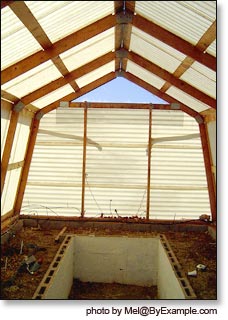 The first gardening project we tackled this spring involved
modifying the existing greenhouse (photo at right) to increase its passive solar
qualities. The original greenhouse erected by the Avalon's
consists of a simple wood frame built over a cinder block
greenhouse bed and enclosed by semi-opaque corrugated
fiberglass. It's inside dimensions are about 8' x 16', it has a
pitched roof and a door entering from the east. While this
initial greenhouse structure provides ample shade for the plants
during the intense summer months, it's design is not suited for
cultivation during the colder seasons. Fortunately, the
original greenhouse was constructed with an East to West
alignment, which has made it fairly easy to enhance its passive
solar heating and cooling abilities.
The first gardening project we tackled this spring involved
modifying the existing greenhouse (photo at right) to increase its passive solar
qualities. The original greenhouse erected by the Avalon's
consists of a simple wood frame built over a cinder block
greenhouse bed and enclosed by semi-opaque corrugated
fiberglass. It's inside dimensions are about 8' x 16', it has a
pitched roof and a door entering from the east. While this
initial greenhouse structure provides ample shade for the plants
during the intense summer months, it's design is not suited for
cultivation during the colder seasons. Fortunately, the
original greenhouse was constructed with an East to West
alignment, which has made it fairly easy to enhance its passive
solar heating and cooling abilities.
Improving Insulation in the Greenhouse
Our goal has been to modify the existing greenhouse to store as much solar energy as possible. In order to make the structure more passive solar we primarily focused on improving insulation in the greenhouse. We began by patching cracks in the fiberglass and filling gaps in the original construction with spray foam insulation. Then on the interior wall and roof of the North side of the building we tacked up R19 fiberglass insulation. Once the insulation was stapled in place we attached plywood sheets to the preexisting frame to form the interior wall and ceiling on the North side. Because sunlight primarily enters the greenhouse from the South side, a heavily insulated North wall will help the greenhouse to retain greater heat with only a minimal reduction in the amount of light reaching the plants. We painted the plywood white not only to protect the wood, but also to reflect and amplify the natural light received from the South.
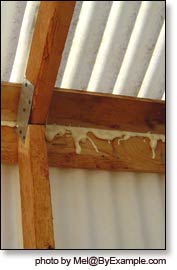

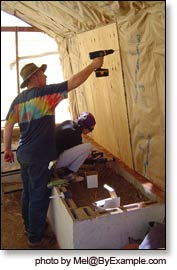
On the South side of the greenhouse we improved insulation by attaching clear plastic sheet and plastic UV protected glazing (recycled from a neighbor's greenhouse kit) to the interior frame of the greenhouse. By attaching the plastic to the interior of the greenhouse frame we created an insulating air pocket between the outside corrugated fiberglass and the interior glazing. Our use of clear materials ensures ample light is able to reach the plants from the South and that solar radiation can be used to warm the room in colder months.
Once we bolstered up the South and North sides of the greenhouse we sealed up the crack at the peak of the roof with a piece of metal flashing. We also constructed a heavier door for the greenhouse using recycled wood and styrofoam sheet to help the structure to retain maximum solar energy.
Solar Greenhouse Ventilation
We are currently working on modifications to the greenhouse that
will make it possible to ventilate and cool the structure
passively. We will be making a screen door for the summertime
that will allow air to circulate into the building. While, the
original greenhouse had a screen vent located near the roof on
each end of the structure, our ventilation strategy calls for
only one window in addition to the screen door. 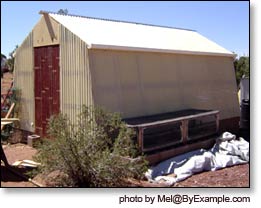 The window will
be placed as close to the roof as possible and will be on the
West wall opposite the doorway. We'd like to be able to easily
close the window at night, however we have yet to come up with a
suitable solution as a result of its high placement . Once we
have the screen door and the single vent in place, air should
circulate through the greenhouse. As the greenhouse interior
warms the hottest air will naturally begin to rise to the
highest point. As fresh air blows in through the screen door,
the hottest air will circulate up and out the vent near the
roof. This should create a circulating air current and cool the
temperature in the greenhouse.
The window will
be placed as close to the roof as possible and will be on the
West wall opposite the doorway. We'd like to be able to easily
close the window at night, however we have yet to come up with a
suitable solution as a result of its high placement . Once we
have the screen door and the single vent in place, air should
circulate through the greenhouse. As the greenhouse interior
warms the hottest air will naturally begin to rise to the
highest point. As fresh air blows in through the screen door,
the hottest air will circulate up and out the vent near the
roof. This should create a circulating air current and cool the
temperature in the greenhouse.
Greenhouse Plans and Global Warming
As part of a future project we would like to expand the greenhouse growing space by attaching cold frames to the South side of the structure. Attaching the cold frames to the sunny side of the greenhouse will help us to lengthen our vegetable growing season. As the effects of global warming increase, sporadic temperatures and unpredictable weather are sure to make outdoor growing more challenging. With cold frames abutting the cinder block section of the greenhouse the warmth that is stored in the thermal mass of the greenhouse will be shared with the outdoor beds.
Another project that we will be addressing in the near future is the development of an irrigation system for the greenhouse. The current greenhouse is equipped with gutters on either side that collect and transfer rainwater into several large rain catch barrels. Ultimately we hope to develop a greenhouse irrigation system that incorporates the rain catch collected from the roof the structure.
Passive Solar Greenhouse Thrives
We were able to move seedlings into the greenhouse by early April. The extra insulation and modifications has allowed the greenhouse to hold onto its warmth through the night and keep temperatures well above freezing. This May we've had two unseasonably cold nights where temperatures have unexpectedly dropped below freezing, but all the plants and seedlings in our modified passive solar greenhouse stayed plenty warm.
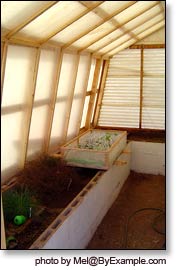
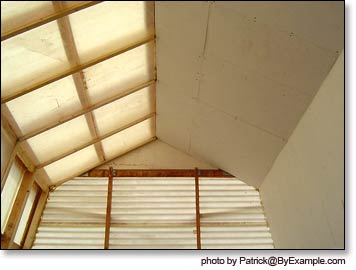
Most of the seedlings have been moved to the outdoor garden or planted in the greenhouse at this point. Aside from seedling trays, the space in the greenhouse is devoted to growing herbs and growing tomatoes. Many of the herbs growing in our organic greenhouse beds have come up again from last year: beautiful chives, rosemary, thyme, peppermint and lemon balm, as well as plenty of volunteer savory. Lettuce, spinach, and basil are also grown in the greenhouse, as well as edible nasturtiums. Before the plants get too much bigger we have plans to tie a string trellis in the form of a grid or web across the greenhouse to help support the weight of our rapidly growing tomatoes.
Why Home Grown Organic Food?
For starters, we like the taste of organic food - every vegetable is full of flavor and when you grow it yourself its picked fresh the very day that you eat it. As food lovers delicious, home grown, organic food is an obvious first choice. By producing our own organic vegetables we also gain control over the quality and condition of the food we consume. We know without doubt where and how it was produced from seeds to harvest. To top it all off, producing organic food locally means there's little or no transportation necessary to obtain quality goods - there's no cross continental shipping and we don't even have to drive to the store!
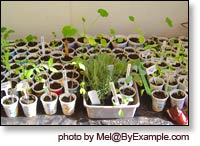


Organic Vegetable Gardening
Click here to read more about our organic gardening experiences.